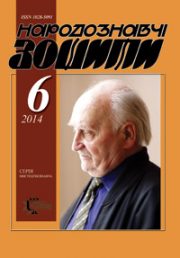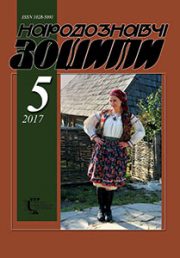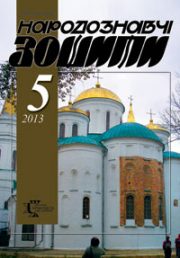The Ethnology Notebooks. 2022. № 2 (164), 314—326
UDK 94(477.83) 801.81
DOI https://doi.org/10.15407/nz2022.02.314
DEMEDYUK Мaryna
- ORCID ID: https://orcid.org/0000-0003-4415-002X
- Candidate of Philological Sciences (= Ph. D. in Philology),
- Senior Researcher at the Institute of Ethnology
- of the National Academy of Sciences of Ukraine,
- Department of Folkloristics,
- 15, Svobody Avenue, 79000, Lviv, Ukraine,
- Contacts: e-mail: mdemedyuk@gmail.com
Abstract. The article explores the plots, motives, and characters that shaped the perception of the Kolky Insurgent Republic as a center of the national liberation struggle of Ukrainians during the Nazi occupation.
The author discovers that stories concerning World War II in the Manevychi area in the Volyn region revolve around the formation, existence, and destruction of the rebel administration in Kolky and the surrounding villages.
The goal of this investigation is to look at the characteristics and transformation of the image of the Kolky Insurgent Republic in the oral traditional prose of Volyn Polissya residents.
The object of the study is folklore narratives, which the author recorded during the folklore trips in 2018—2021, and the subject is the reflection in the texts of events related to the existence of the insurgent center in the Kolky area during WWII.
The work’s methodology is based on the concepts of objectivity and folkloristic historicism, with structural-typological and conceptual analysis as the primary methods. The authors employ elaborations on the subject of autobiographical story study around the world and in Ukrainian scientific discourse. It is underlined that, in recent years, as the area of oral science has expanded, the study of historical narratives has become more relevant in the emphasis of Ukrainian folklore research papers (works of E. Lunyo, O. Kuzmenko, O. Britsyna, L. Khalyuk, etc.).
The author observes that in the town of Kolky and the neighboring villages, tales concerning the existence of the insurgent center mostly focus on the operations of insurgent schools and nursing schools.
The heroic image of the Kolky insurgents is reduced to a series of events with a list of the most important pages in the Kolky Republic’s history.
The emphasis is on the antagonism of «their» insurgents and alien Germans, Soviet guerrillas, in descriptions of active participants that are often impersonal. When portraying UPA troops during the Kolky Republic’s period, physical attributes such as youth, beauty, height, physical strength, and good moral qualities become important.
The author underlines that the account of the tragic pages of the Kolky Republic’s annihilation, which was accompanied by the bombing of Kolky and the burning of several nearby towns and hamlets, is the most numerous set of writings relating to the era of its existence.
Keywords: folklore text, narratives, World War II, national liberation struggle, Volyn, Kolky Insurgent Republic.
Received 29.04.2022
REFERENCES
- Bondaruk, L. (Ed.). (2003). Routes of generations: a guide to the heroic paths of the UPA in Volyn. Lutsk: Volyn Art Agency «Teren» [in Ukrainian].
- Kokhans’ka, H. (2008). With Ukraine in the heart: memories. Lviv; Toronto: Chronicle of the Ukrainian Insurgent Army [in Ukrainian].
- Semenyuk, S. (1997). Memories of Kolky in the national liberation struggle of the OUN—UPA. The city of Kolky is an important spiritual center of Volyn Polissya (to the 800th anniversary of its foundation (Pp. 59—65). Lutsk [in Ukrainian].
- Baida, T. (2008). Baptized by fire. Lutsk: Volyn Regional Printing House [in Ukrainian].
- Mosiychuk, P. (2018). Resistance. Ternopil: Textbooks and manuals [in Ukrainian].
- Antonyuk, J. (2014). Ukrainian liberation movement in the form of its leaders. Volyn and Brest regions (1939—1955). Toronto; Lviv: Litopys UPA Publishing House [in Ukrainian].
- Nikonchuk, O. (2007). The Kolk Republic. The way of liberation, 3, 77—88 [in Ukrainian].
- Kovalchuk, V. (2006). Activities of the OUN (b) and the back of the UPA in Volyn and southern Polissya (1941—1944). In Chronicle of the Ukrainian Insurgent Army (Vol. 7, pp. 1—497). Toronto; Lviv [in Ukrainian].
- Novak, M. (1984).North-Western District of Turiv. In Chronicle of the Ukrainian Insurgent Army. Volyn and Polissya. German occupation (Vol. 5, book. 3, pp. 96—135.). Toronto: Litopys UPA Publishing House [in Ukrainian].
- Bondaruk, L. (2019). The Kolky Republic of Freedom. Retrieved from: https://history.rayon.in.ua/topics/386270-kolkivska-respublika-svobodi (Last accessed: 21.04.2022) [in Ukrainian].
- Labashchuk, O. (2016). Achievements and prospects of research of autobiographical stories in folklore. Methodological study (Vol. 43, pp. 14—22). Retrieved from: http://nbuv.gov.ua/UJRN/studmethod_2016_43_4 (Last accessed: 21.04.2022) [in Ukrainian].
- Demyan, G. (2006). Stepan Bandera and his family in folk songs, legends, and memoirs. Lviv: Afisha [in Ukrainian].
- Kyrchiv, R. (2010). The twentieth century in Ukrainian folklore. Lviv: Institute of Ethnology of the National Academy of Sciences of Ukraine [in Ukrainian].
- Lunyo, E. (2007). The figure of Roman Shukhevych in the narrative folklore of the Yavoriv region. Ukrainian liberation movement (Vol. 10, pp. 203—224) [in Ukrainian].
- Kuzmenko, O. (2018). Dramatic existence of a human in Ukrainian folklore: conceptual forms of expression (the period of the First and Second World Wars). Lviv: Institute of Ethnology of the National Academy of Sciences of Ukraine [in Ukrainian].
- Halyuk, L. (2013). Oral narratives of Ukrainian immigrants from Lemkivshchyna, Kholmshchyna, Podlasie, and Nadsyannia: genre-and-thematic specifics, artistic features. Kyiv [in Ukrainian].
- Sokil, V. (2017). Folklore prose about the famines of the twentieth century in Ukraine: the paradigm of the text. Lviv [in Ukrainian].
- Sokhan’, P., & Shtendera, Y. (Ed.). (1999). Chronicle of the Ukrainian Insurgent Army. New series (Vol. 2: Volyn and Polissya: UPA and Zapillya 1943—1944). Kyiv; Toronto [in Ukrainian].






